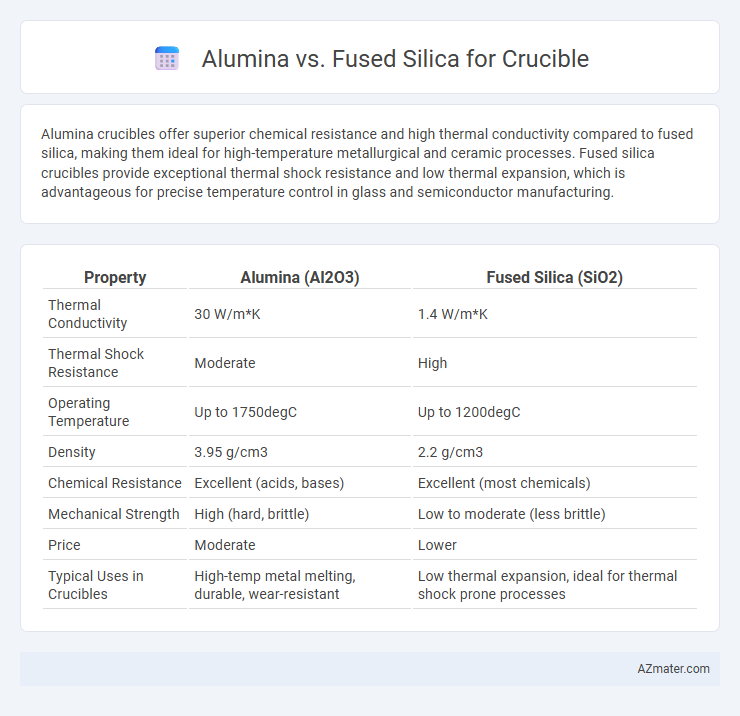Alumina crucibles offer superior chemical resistance and high thermal conductivity compared to fused silica, making them ideal for high-temperature metallurgical and ceramic processes. Fused silica crucibles provide exceptional thermal shock resistance and low thermal expansion, which is advantageous for precise temperature control in glass and semiconductor manufacturing.
Table of Comparison
| Property | Alumina (Al2O3) | Fused Silica (SiO2) |
|---|---|---|
| Thermal Conductivity | 30 W/m*K | 1.4 W/m*K |
| Thermal Shock Resistance | Moderate | High |
| Operating Temperature | Up to 1750degC | Up to 1200degC |
| Density | 3.95 g/cm3 | 2.2 g/cm3 |
| Chemical Resistance | Excellent (acids, bases) | Excellent (most chemicals) |
| Mechanical Strength | High (hard, brittle) | Low to moderate (less brittle) |
| Price | Moderate | Lower |
| Typical Uses in Crucibles | High-temp metal melting, durable, wear-resistant | Low thermal expansion, ideal for thermal shock prone processes |
Introduction to Crucible Materials
Alumina and fused silica are two primary materials used in crucible manufacturing, chosen for their exceptional thermal stability and resistance to chemical corrosion. Alumina crucibles exhibit high melting points above 2072degC and excellent mechanical strength, making them ideal for processing aggressive molten metals and ceramics. Fused silica offers superior thermal shock resistance and low thermal expansion, which is critical for processes requiring rapid temperature changes and high purity environments.
Overview of Alumina Crucibles
Alumina crucibles, composed primarily of aluminum oxide (Al2O3), exhibit exceptional thermal stability and chemical resistance, making them ideal for high-temperature applications such as metal melting and chemical synthesis. Their superior mechanical strength and resistance to corrosion outperform fused silica, which is more brittle and less suitable for aggressive environments. Alumina crucibles maintain structural integrity at temperatures above 1700degC, providing durability and longevity in demanding laboratory and industrial processes.
Properties of Fused Silica Crucibles
Fused silica crucibles exhibit exceptional thermal shock resistance and ultra-low thermal expansion, making them ideal for high-temperature applications requiring dimensional stability. Their high purity and chemical inertness ensure minimal contamination and excellent corrosion resistance when handling aggressive molten metals and glass. With superior optical transparency and excellent dielectric properties, fused silica crucibles are preferred in semiconductor manufacturing and precision material processing.
Thermal Performance Comparison
Alumina crucibles exhibit high thermal conductivity and excellent resistance to thermal shock, making them suitable for rapid heating and cooling cycles up to 1750degC. Fused silica crucibles offer superior thermal insulation due to very low thermal expansion and maintain structural integrity under thermal stress but have a lower maximum operating temperature around 1200degC. Choosing between alumina and fused silica depends on the required operating temperature and the need for thermal shock resistance versus thermal insulation.
Chemical Resistance: Alumina vs Fused Silica
Alumina crucibles exhibit superior chemical resistance to alkalis and acidic environments, making them ideal for applications involving aggressive chemicals and high-temperature reactions. Fused silica offers excellent resistance to high-temperature thermal shock and corrosive environments, especially with molten metals and glass melts, due to its high purity and low thermal expansion. Choosing between alumina and fused silica crucibles depends on the specific chemical conditions, with alumina preferred for strong acidic or basic media and fused silica favored for high-purity, low-contamination processes.
Mechanical Strength and Durability
Alumina crucibles exhibit superior mechanical strength and higher thermal shock resistance compared to fused silica, making them ideal for high-temperature applications. Fused silica offers exceptional chemical durability and low thermal expansion but is more brittle and prone to fracture under mechanical stress. The enhanced toughness of alumina ensures longer lifespan in demanding environments, while fused silica is preferred for processes requiring extreme purity and minimal contamination.
Cost Analysis: Alumina and Fused Silica
Alumina crucibles generally exhibit higher material costs due to their superior thermal stability and mechanical strength, making them suitable for high-temperature applications. Fused silica crucibles offer lower raw material and fabrication expenses, attributed to their higher purity and lower density, but may have shorter lifespans in aggressive thermal cycles. Cost analysis must consider not only initial purchase price but also durability, thermal shock resistance, and maintenance frequency to determine overall economic efficiency.
Typical Applications in Industry
Alumina crucibles are widely used in high-temperature applications such as metal casting, chemical processing, and ceramics manufacturing due to their excellent thermal stability and resistance to corrosion. Fused silica crucibles excel in semiconductor and optical industries because of their ultra-low thermal expansion and high purity, ensuring minimal contamination during processes like crystal growth and semiconductor wafer fabrication. Both materials are essential in laboratory and industrial settings where thermal shock resistance and chemical inertness are critical.
Selection Criteria for Crucible Material
Selecting between alumina and fused silica for crucibles depends on thermal stability, chemical resistance, and purity requirements. Alumina crucibles offer superior high-temperature strength up to 1750degC and excellent resistance to chemical attack from acids and molten metals, making them ideal for harsh industrial processes. Fused silica excels in thermal shock resistance and low thermal expansion with a lower maximum operating temperature around 1200degC, suitable for applications requiring rapid temperature changes and high purity.
Conclusion: Choosing the Right Crucible
Alumina crucibles offer superior chemical resistance and high-temperature stability, making them ideal for melting aggressive metals and alloys. Fused silica crucibles provide excellent thermal shock resistance and low thermal expansion, suitable for precision applications requiring rapid temperature changes. Selecting the right crucible depends on the specific thermal properties, chemical compatibility, and operational conditions of the intended use.

Infographic: Alumina vs Fused silica for Crucible
 azmater.com
azmater.com